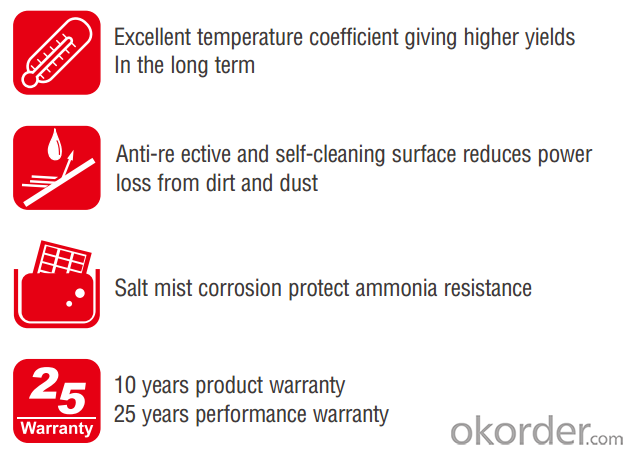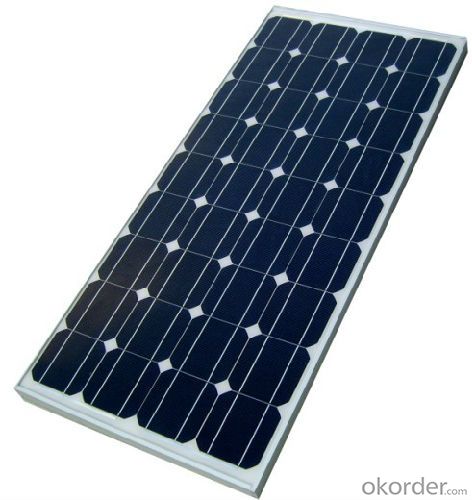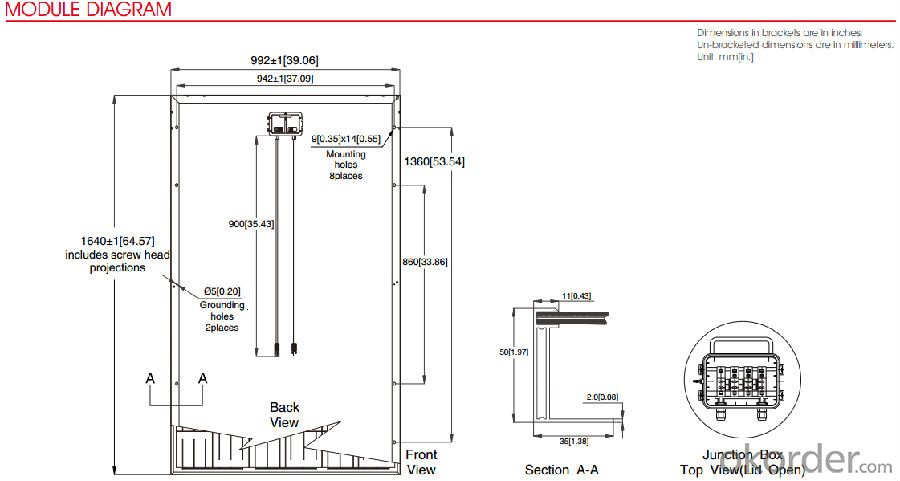High Efficiency Polycrystalline PV Module 250W-260W
- Loading Port:
- China Main Port
- Payment Terms:
- TT or LC
- Min Order Qty:
- -
- Supply Capability:
- -
OKorder Service Pledge
OKorder Financial Service
You Might Also Like
Structure
High Efficiency Polycrystalline PV Module.250W-260W
Solar panel refers either to a photovoltaics (PV) module, a solar hot water panel, or to a set of solar photovoltaics modules electrically connected and mounted on a supporting structure. A PV module is a packaged, connected assembly of solar cells. Solar panels can be used as a component of a larger photovoltaic system to generate and supply electricity in commercial and residential applications.
Features
Nominal 20V DC for standard output.
Out standing low-light performance.
Heavy-duty anodized frames.
High transparent low-iron, tempered glass.
Rugged design to withstand high wind pressure, hail and snow load.
Aesthetic appearance.



Images



Specification



FAQ
Q:How to guarantee the quality of the products?
A:We have established the international advanced quality management system,every link from raw material to final product we have strict quality test;We resolutely put an end to unqualified products flowing into the market. At the same time, we will provide necessary follow-up service assurance.
Q:Can we visit your factory?
A:Sure,welcome at any time,seeing is believing.
Q:Which payment terms can you accept?
A:T/T,L/C,Moneygram,Paypal are available for us.
- Q:Can solar cells be used in countries with limited sunlight?
- Yes, solar cells can still be used in countries with limited sunlight. While solar cells are most efficient in areas with abundant sunlight, they can still generate electricity even in regions with limited sunlight. Advances in technology have made solar cells more efficient and capable of capturing and converting sunlight into electricity even in low-light conditions. Additionally, solar cells can be combined with battery storage systems to store excess energy generated during sunny periods for use during cloudy or nighttime hours. Thus, solar cells can be a viable and sustainable energy solution in countries with limited sunlight.
- Q:Can solar cells be used in airports?
- Yes, solar cells can be used in airports. They can be installed on rooftops, canopies, or other open spaces in airports to generate clean and renewable energy for various purposes such as lighting, power supply, and charging stations. Additionally, solar cells can contribute to reducing the carbon footprint and overall energy costs of airports.
- Q:Can solar cells be used in shopping centers?
- Yes, solar cells can be used in shopping centers. They can be installed on the rooftops or in parking lots to generate clean and renewable energy to power the shopping center's operations. Solar cells provide cost savings on electricity bills and reduce carbon emissions, making them an environmentally friendly choice for shopping centers.
- Q:How do solar cells handle snow or ice accumulation?
- Solar cells can handle snow or ice accumulation by either melting the snow or ice due to their ability to absorb sunlight and convert it into electricity, or by allowing the snow or ice to slide off the surface due to their smooth and slippery design. Additionally, some solar panels are tilted at an angle, which helps prevent snow or ice buildup by allowing it to slide off more easily.
- Q:What is the usage of solar cells?
- Solar cells were first used as as an alternative power source to the primary battery power source.
- Q:Can solar cells be used for powering agricultural equipment?
- Yes, solar cells can be used for powering agricultural equipment. Solar energy can be harnessed through photovoltaic (PV) panels and used to power various agricultural machinery and equipment such as pumps, irrigation systems, electric fences, and machinery used for crop processing. This provides a sustainable and environmentally friendly alternative to traditional fuel-based power sources, reducing operating costs and minimizing carbon emissions in the agricultural sector.
- Q:How do solar cells perform in high humidity environments?
- Solar cells can still perform well in high humidity environments. However, excessive moisture in the air can potentially reduce their overall efficiency.
- Q:Can solar cells be used in data centers or server farms?
- Yes, solar cells can be used in data centers or server farms. By installing solar panels, these facilities can generate renewable energy to power their operations. However, the feasibility and effectiveness of using solar cells in data centers may depend on factors such as the location, available space, energy demands, and storage capacity. Additionally, combining solar power with other energy sources and implementing energy-efficient practices can further optimize the sustainability of data centers and server farms.
- Q:What is the role of bypass diodes in solar cell systems?
- The role of bypass diodes in solar cell systems is to prevent the damage caused by shading or partial shading of the solar panels. These diodes provide an alternate path for the current to flow when some portions of the solar panels are shaded, ensuring that the rest of the panels can still generate electricity efficiently. By diverting the current around the shaded area, bypass diodes help to maintain the overall performance and reliability of the solar cell system.
- Q:How do solar cells perform in high-altitude locations?
- Solar cells perform well in high-altitude locations due to several factors. Firstly, at higher altitudes, there is less atmospheric pollution and dust, resulting in cleaner and clearer sunlight, which enhances the performance of solar cells. Additionally, the thinner atmosphere at high altitudes allows for less scattering and absorption of sunlight, enabling solar cells to receive a higher intensity of solar radiation. This combination of cleaner and more intense sunlight makes solar cells more efficient and productive in high-altitude locations.
1. Manufacturer Overview |
|
|---|---|
| Location | |
| Year Established | |
| Annual Output Value | |
| Main Markets | |
| Company Certifications | |
2. Manufacturer Certificates |
|
|---|---|
| a) Certification Name | |
| Range | |
| Reference | |
| Validity Period | |
3. Manufacturer Capability |
|
|---|---|
| a)Trade Capacity | |
| Nearest Port | |
| Export Percentage | |
| No.of Employees in Trade Department | |
| Language Spoken: | |
| b)Factory Information | |
| Factory Size: | |
| No. of Production Lines | |
| Contract Manufacturing | |
| Product Price Range | |
Send your message to us
High Efficiency Polycrystalline PV Module 250W-260W
- Loading Port:
- China Main Port
- Payment Terms:
- TT or LC
- Min Order Qty:
- -
- Supply Capability:
- -
OKorder Service Pledge
OKorder Financial Service
Similar products
New products
Hot products
Related keywords




























